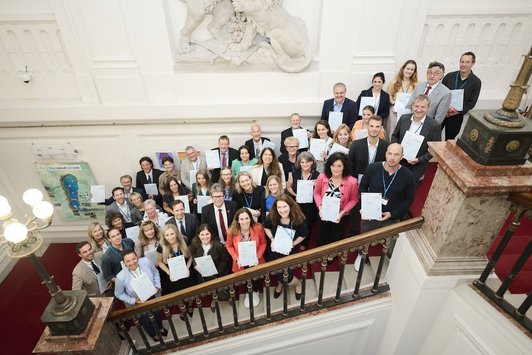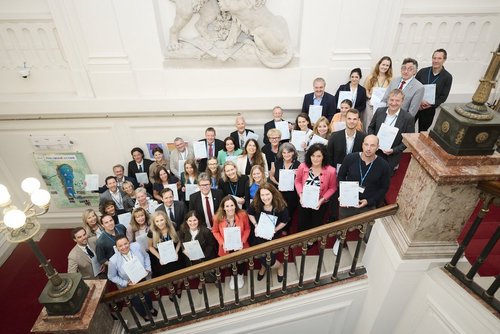BMBWF and OeAD honour 46 schools with the Young Science quality seal for research partner schools
Martin Polaschek, Federal Minister of Education, Science and Research, and OeAD Managing Director Jakob Calice awarded the Young Science seal of approval for research partner schools in Vienna on 10 June 2024. A record-breaking 46 schools were able to convince the jury, consisting of experts from research, science communication and school development. The award-winning schools were honoured because, for example, they had established a research-oriented school focus, worked on research projects, cooperated with research institutions or carried out other research-related activities.
To the award-winning schools: www.youngscience.at/forschungspartnerschulen
"With the Young Science Seal of Approval, we are recognising the efforts of numerous research partner schools that focus on communicating science and research and getting pupils excited about it. The honoured schools prove that research cooperation knows no boundaries and enriches everyday school life. By getting young people interested in scientific research, schools build a bridge between society and science and strengthen trust in science and democracy," says Martin Polaschek, Federal Minister of Education, Science and Research.
What all schools that successfully cooperate with scientific institutions have in common is the above-average commitment of the school management and the high level of professionalism of the teaching staff, who are involved in research projects together with the children and young people.
"In recent years, we have observed a growing interest among schools in integrating science education into everyday school life, for example through Sparkling Science 2.0 or visits by science ambassadors. The research partner schools go one step further. They regard research as an integral part of their school culture and collaborate with research institutions in a variety of creative ways, starting at primary school level. The schools thus assume a special role model function, as they demonstrate innovative model solutions for cooperation between research and education," explains OeAD Managing Director Jakob Calice.
Call for proposals 2024
The 7th call for proposals ran from 10 January to 4 March 2024 and met with lively interest. Almost twice as many schools submitted applications for the seal of quality as in previous calls. Of 58 valid submissions, 46 were recognised, of which 27 were first-time certifications and 19 were recertifications.
Award-winning schools by school type and province
16 BMHS, 15 AHS, 8 primary schools, 6 secondary schools and one polytechnic school were awarded the coveted seal. 16 of the award-winning schools are located in Vienna, 11 in Styria, seven in Upper Austria, four in Salzburg, three in Lower Austria, a further three in Tyrol and one each in Burgenland and Carinthia.
About the seal of quality
There are many schools in Austria that co-operate successfully with research institutions. The BMBWF and the OeAD have been awarding the Young Science Seal of Approval for research partner schools since 2012 to recognise the exceptional commitment of these school administrators and teachers and to set an example. Between 2012 and 2024, 80 research partner schools have qualified for the award in the course of seven calls for applications to date. The seal is awarded for a period of two years. Schools that have already been awarded the seal must apply for re-certification as part of the calls for applications and provide evidence of the further development of their research focus.
All Austrian public and public schools are eligible to apply for the Young Science Seal of Quality, provided they carry out projects in which pupils are actively involved in research processes. Collaboration in research projects should also be reflected in the school profile and in research-oriented teaching programmes. Furthermore, it is planned to involve not only individual pupils with a particular interest in the projects, but also entire school classes or larger groups.
Further information
Link to the APA photo gallery


